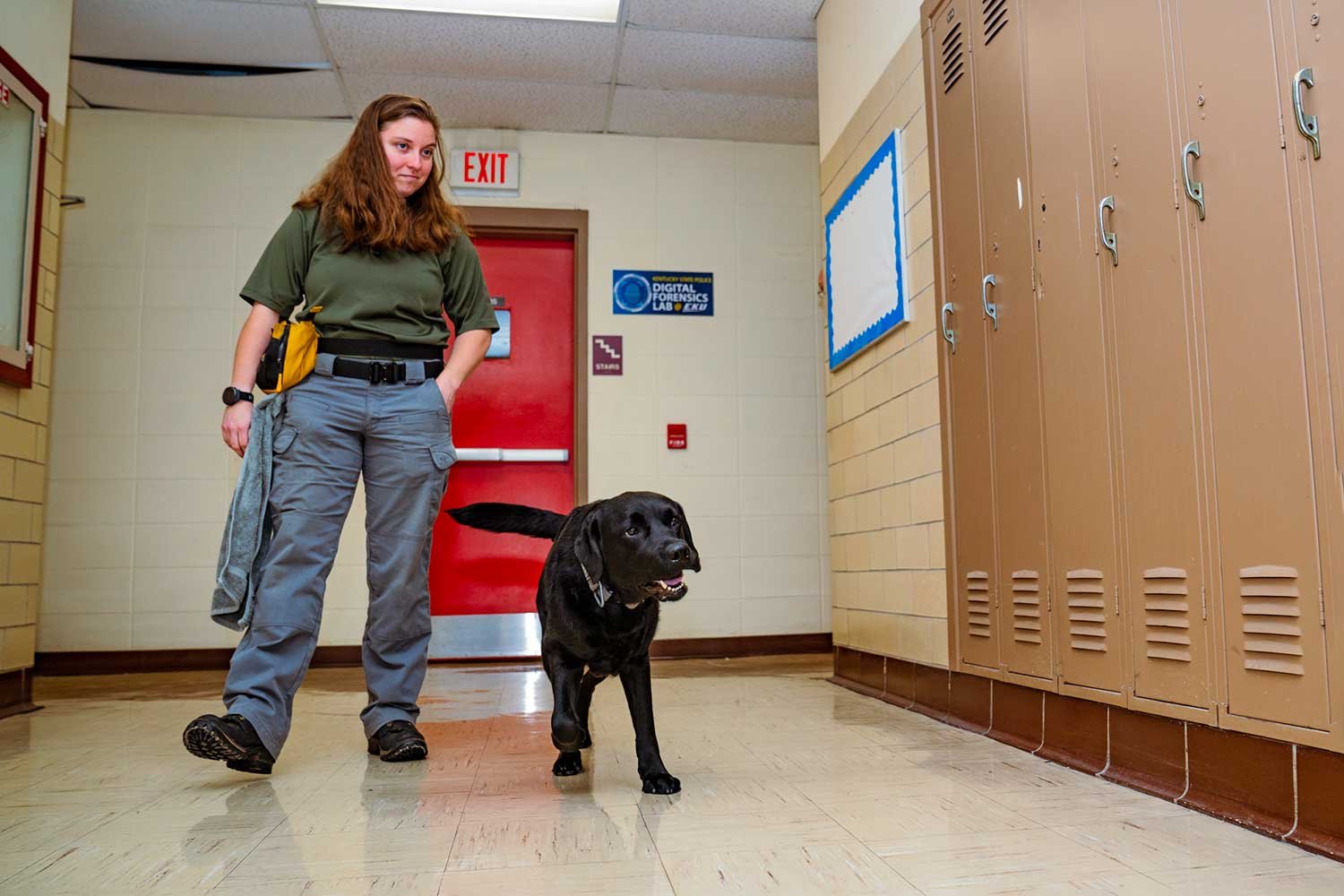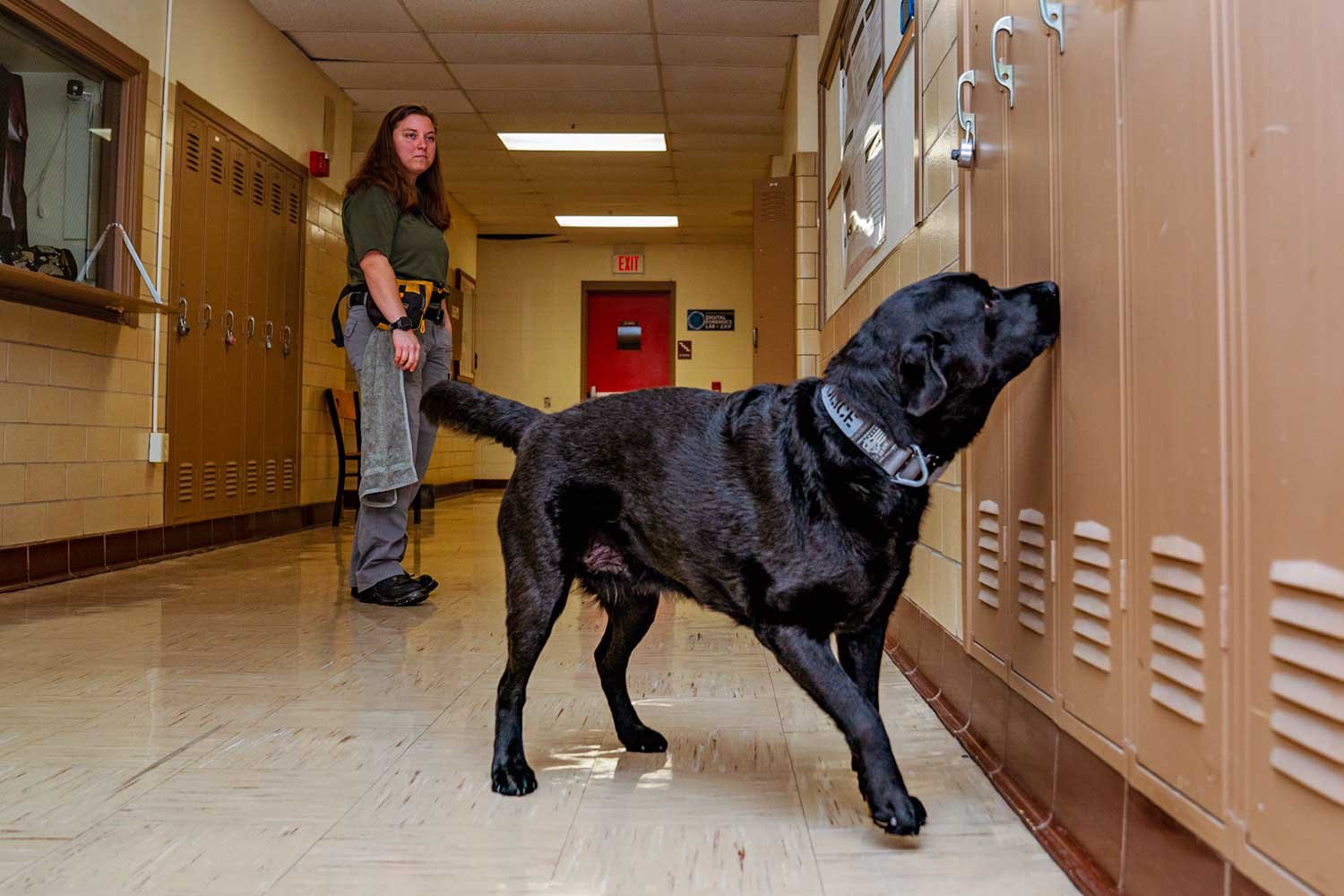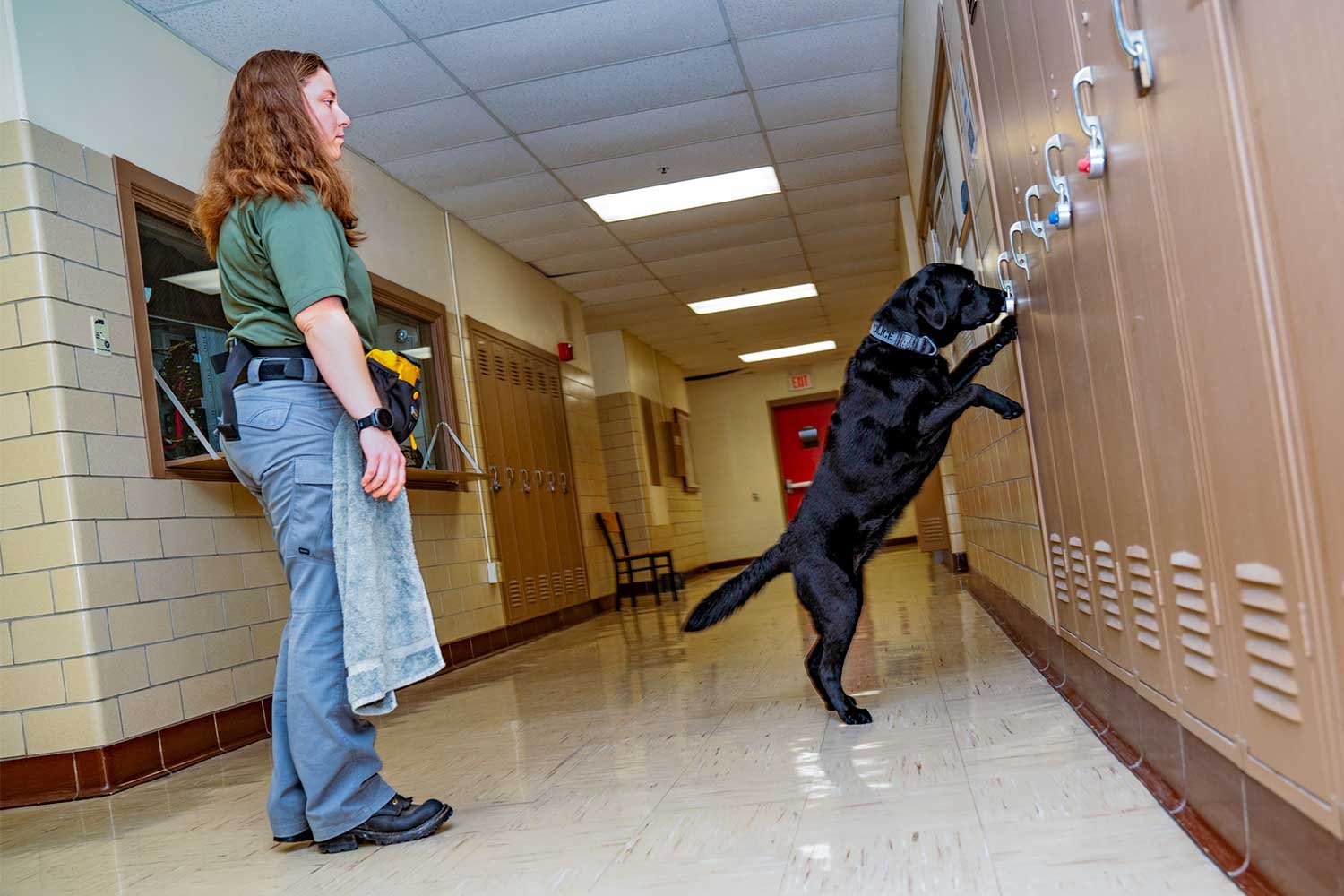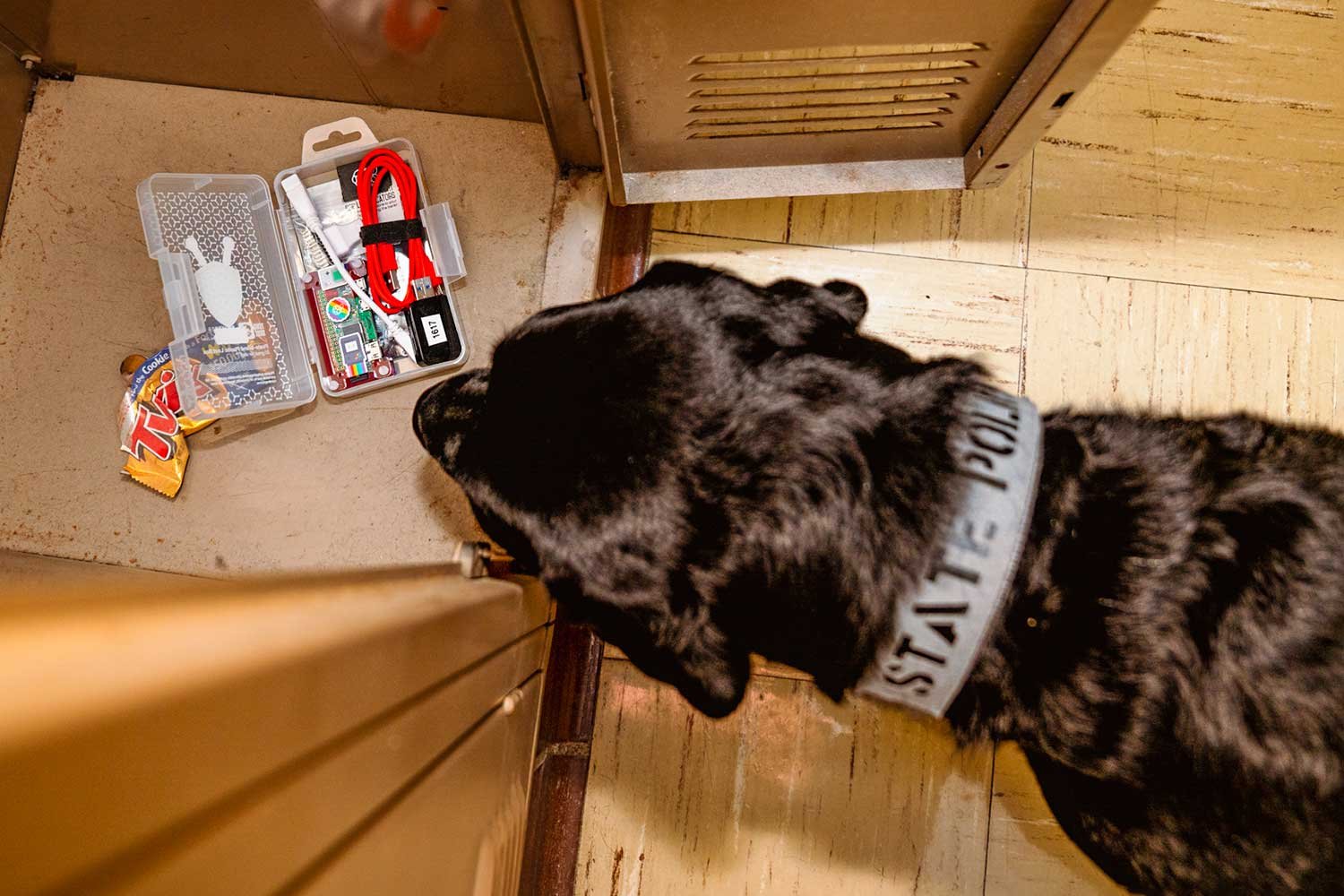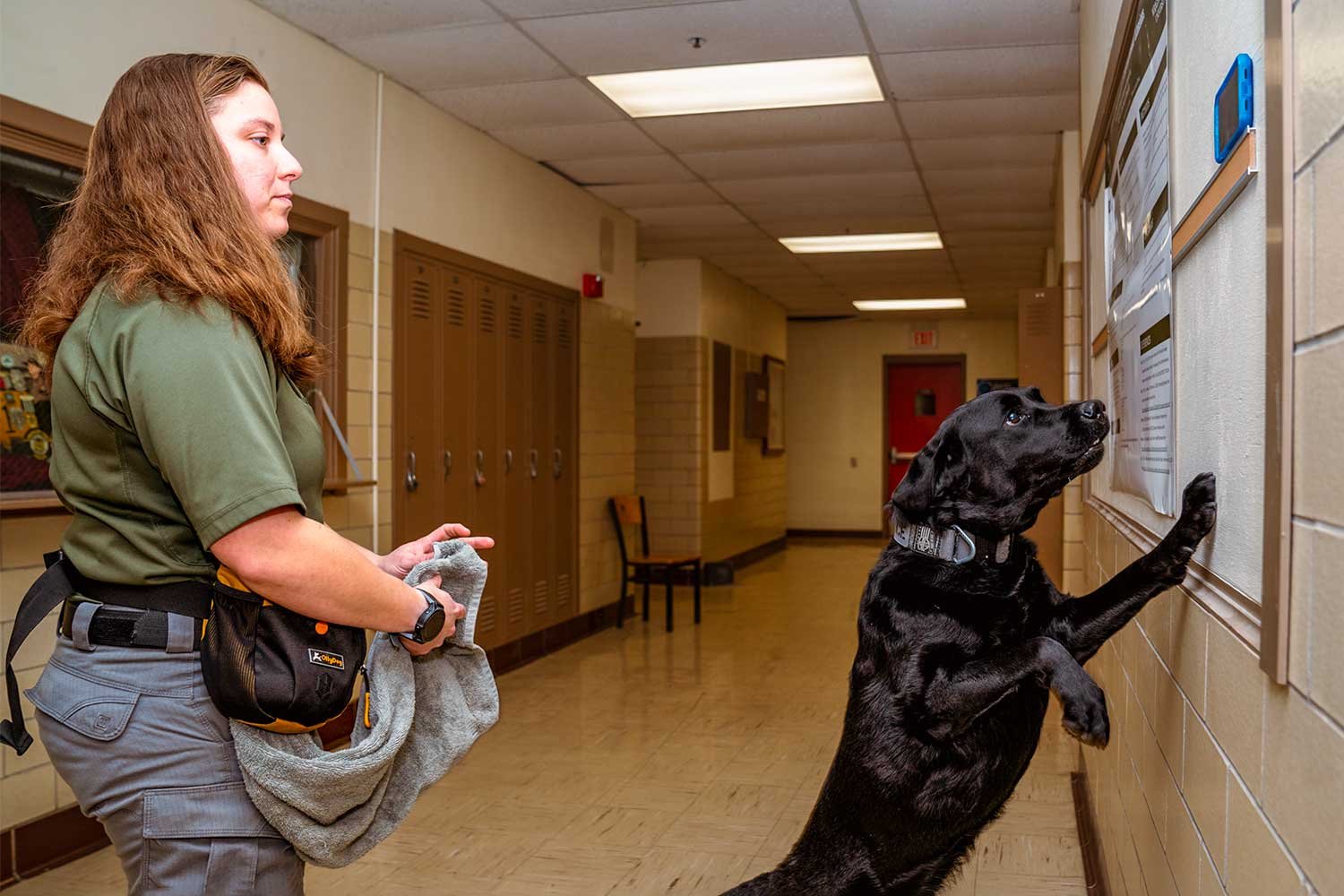A Nose for The Job
PICTURED ABOVE
May and her handler KSP Sgt. Leslie Strong have worked 36 search warrants and 21 presentations since March 2021. Strong said May isn’t a probable cause K-9. She is a tool that is used to help KSP locate electronic devices. (Photo by Jim Robertson)
May is a fun-loving sweetheart of a dog. But don’t let the playfulness of the 3-year-old black Labrador Retriever fool you. When it comes to working, she’s all business.
May and Cam are two Labrador Retrievers who can sniff out electronic devices. Both are valued members of the Kentucky State Police’s Electronic Crimes Branch and serve as electronic storage devices (ESD) detection dogs.
The dogs, trained by Jordan Detection K9 in Indianapolis, Ind., can detect the chemical coating – Triphenylphosphine oxide (TPPO) – that prevents motherboards in electronics from overheating.
“It’s the chemical they’re trained to detect,” said Sgt. Leslie Strong, May’s handler. “These are not probable cause dogs. They’re a tool. It’s like using a metal detector on a scene. They help us find what we’re looking for.”
Cam and his handler, Detective John Sims, are based out of Mayfield.
“We average about one (call out) per week,” Strong said. “If it’s far west, Detective Sims and Cam will take it. If it is centrally located, sometimes we’ll both go.”
Strong said the dogs are used frequently in Internet Crimes Against Children (ICAC) cases.
“The Electronic Crime Branch is part of that task force, and the Kentucky State Police is the head of the task force in Kentucky,” Strong said. “That is about 98% of what we do.”
One of the more well-known cases an ESD dog worked on was the 2015 case against former Subway spokesperson Jared Fogle. An ESD dog named Bear located key electronic evidence in Fogle’s home, leading to his conviction.
ESD dogs prove their worth during cases because it is not uncommon for people suspected in crimes where electronics are involved to hide or attempt to dispose of them if being chased, Strong said.
“If there is a foot pursuit and the suspect throws their phone, for example, (down a hill, into a wooded area, etc.) and (law enforcement is) not sure where it went, we can go. Any electronic device with that coating on it and there’s a case and (a local agency needs help) they can call us.”
An example of the usefulness of an ESD dog occurred a few months ago in Johnson County.
“The suspect had thrown his phone out, and the sheriff’s office searched for it but couldn’t find it,” Strong explained. “A couple of weeks later, we went there. It had rained, and parts of the phone had washed down the mountain. So, we had that, and we knew where to start searching. I deployed May, and she walked down the trail. She tricked me by turning circles in the trail three or four times, and I was like, ‘What are you doing?’ Then she darted to the side about five or six feet out in waist-deep brush and sat. I said, ‘OK, show me.’ She pointed, and sure enough, parts of the phone were lying there.”
Origins
Strong was already a member of KSP’s ICAC task force, and she had “done a few knock and talks” and helped execute some search warrants where child victims were present.
“I was the female on the scene, and (the victims) felt more comfortable with me because they were dealing with a male perpetrator,” she said.
About four years ago, Strong attended a National Children’s Advocacy Training in Alabama, where she first learned of ESD dogs who were being used on ICAC cases.
One day, the training ended a little early, so I went out in the lobby, and they had one of these dogs, and his handler was there,” Strong explained. “I saw the dog, and I walked over to see it. The handler started telling us what (the dog did), and I said, ‘Wait a minute. You’re ICAC?’ And she was.”
From there, Strong took out her phone, took a picture of the dog, and texted her commander.
“I said, ‘We probably need one of these dogs,’” she said. “I volunteered to be the handler.”
Once Strong returned from the NCAC training, her commander talked further about an ESD dog. Once she gained approval, Strong spent three years researching ESD dogs, which included talking to law enforcement officers who were handlers. Once her research was completed, she wrote a proposal and sent it up her chain of command.
May and Cam
May and Cam are technically dual-purpose dogs. Both were in training to be service animals but flunked out of the training, Strong said.
“The nice way to say it is they’re career-change dogs,” she said. “They are emotional support animals. The ICAC cases we work with have children on the scene, and they help with that. That is more impressive than the detection because I can understand how people train K9s (for traditional police work), but I don’t understand how a dog can be trained for emotional support. So that’s amazing.”
May was the first ESD dog KSP received through a grant from Operation Underground Railroad.
(Photo provided)
Jordan Detection K9 partners with the non-profit organization Operation Underground Railroad and assists law enforcement in rescue efforts of child victims of human trafficking. Part of that project includes providing funds to train ESD K9s like May and Cam, and thanks to this partnership, KSP was able to receive the dogs at no cost to the agency.
Since March 2021, May has worked 36 search warrants deployments and 21 presentations in schools as of mid-November 2022.
“We go into the schools and do internet safety, and K9 programs,” Strong explained. “There are times where we’ll do more presentations than search warrants.”
Handler Training
ESD dog handler training is much different than K9 handlers, which focus on drugs or bombs.
“Those guys with the patrol dogs and narcotics have handler schools,” Strong said. “With us, we don’t train the dogs. The dogs are already trained when we show up. Our school is two weeks long. We spend those two weeks learning how to get out of their way and letting them work.”
And unlike drug or bomb dogs, who are rewarded with a chance to play with a beloved toy, Cam and May are rewarded with food.
“May and Cam are the only food reward K9s we have in the agency,” Strong said. “Because of that, you must train every day because she cannot eat from a bowl. She must work to get her food, so she must train daily.”
Training involves hiding devices in different places,” Strong explained. “It’s the same concept as with other K9s. I have a set of devices I use to train with.”
Strong rotates the devices so that May won’t get used to one scent.
“It’s the same concept for drug or bomb dogs,” she explained. “We just use electronics.”
Additionally, like other K9 handlers, May and Cam live with their handlers. But unlike other K9s, they are like any other dog at home, meaning they don’t have to be confined to a kennel and can interact with people and other pets.
May and Cam are ready to go when the call for service comes.
“Any time something comes up where there is some sort of electronic device involved in a case, we can be called out,” Strong said.
Law enforcement agencies who require their services can call the Electronics Crimes Branch at 502-782-9769. You can keep up with the exploits of Cam and May on their Instagram account @ksp_k9may and @ksp_k9_cam.

